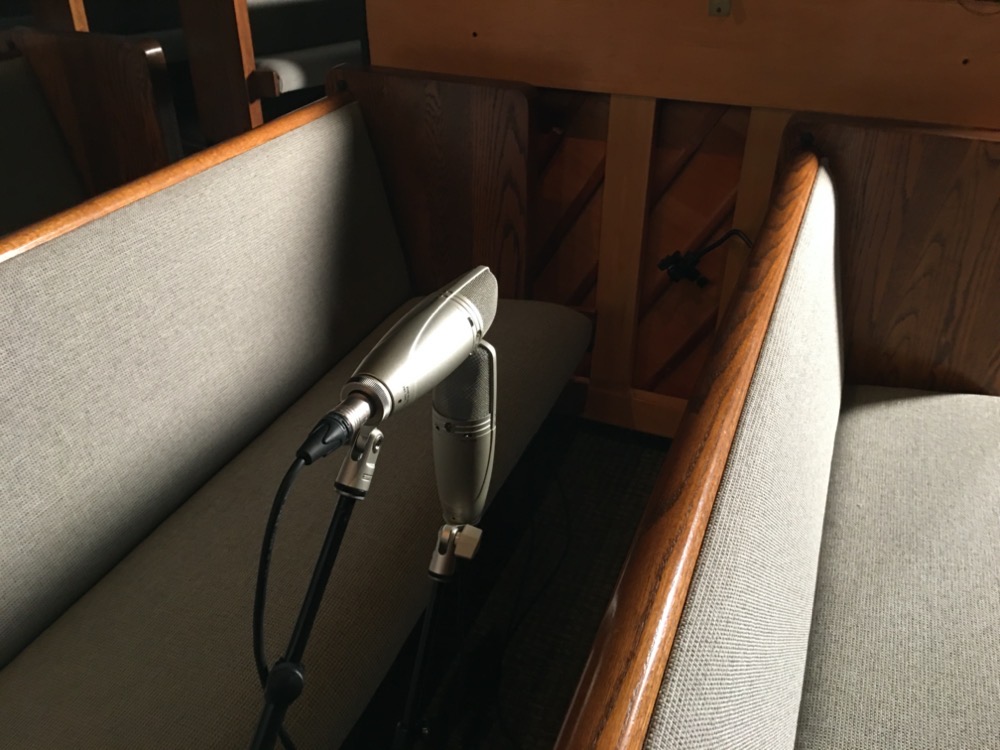
Mixing Songs from an Empty Sanctuary
Last month I wrote about recording a couple of songs for a series of songs my friends at Decatur City Church have been releasing called Songs From an Empty Sanctuary. These were stripped down, piano and vocal renditions, but the mix was surprisingly more involved than I would have thought especially on the version of Reckless Love I worked on. I’ll embed the final version of that song, again, at the end of this post.
First up, vocal processing was pretty simple for the most part. There was a bit of EQ to “un-lav” the lav followed by some compression, and I think some dynamic EQ. Standard stuff for the most part.
The overall performance was very dynamic by design, and I did a fair amount of automation to keep the dynamics suitable for the final streaming destination. Automation was done through manual fader riding and not by drawing in automation. That’s pretty standard for me in my studio, and I have a control surface in my studio for this kind of things. I’m not a fan of drawing automation if I can just use a fader because faders are faster for me.
Now, if you’re getting the impression from these two posts that I’m not a fan of lav mics, you’re sort of right. I have a love-hate thing with them. I love how clean they can sound in some location recording situations. It’s also hard to argue with how inconspicuous they can be in video considering how close you can get them to a source. Even when you can see them, people are used to seeing them so it’s not really a big deal, and they kind of just disappear. However, I just don’t think they sound as good as bigger mics. To me, they don’t have the naturalness of just about every other type of microphone I’ve used on a voice/vocal. Plus, I find there’s a nice hole right around 4k in a lot of the lav recordings I get which kinda sucks when you’re trying to get a voice to sound natural.
To be fair, some–if not most–of that is probably related to mic placement. Let’s be honest for a moment. We put lav’s in places to keep them relatively unobtrusive whether it’s on a shirt or a tie or a collar or behind a button or even as a headworn mic, but none of these places are ideal listening places. We don’t walk up to people and put our heads on their chest in conversations. That would be awkward to say the least. These mic placements “work” for production purposes, but I can get a better sound out of a lot of other mics in much better positions. All that said, if I have to use a lav I’m happy to use the one I had for these shoots.
Being that it was a lav presented most of the challenges for the mix, though. There was a bit of clothing rustle that required some isolated surgery with Izotope RX in post. It wasn’t too extreme, and most of the rustle occurred when LaTricia wasn’t singing. This, of course, begs the question of why I needed to process the rustling in lieu of just dipping the mic.
Well, it turned out there was a TON of low-mid piano bleed in the lav. So the lav became a contributing factor in the sound of the piano. I tried riding the lav down in the breaks as that’s pretty standard for me mixing live recordings, but anything more than a subtle dip was too obvious so I had to leave the mic open for the entire song.
I’ve recorded and mixed a few more of these since I worked on Reckless Love and the Hamilton song, and bleed is part of the nature of the recordings. Everything recorded just adds up to the everything you hear. There is not a lot you can really fix later on because of all the bleed. That’s not a complaint, though. It’s simply something that needs to be considered going into these things, and it kind of works for the end product. These aren’t supposed to be clean, clinical studio sounding recordings. They’re supposed to sound like great musicians playing in an empty room, and the bleed adds character to the whole thing. The trick is just getting the mics in places for the recording so any bleed adds up to something cool and doesn’t hurt the end product.

The bulk of the rest of the piano sound came from the mid-side mics pictured here. As I mentioned in the first post about this recording, mid-side is a method of stereo recording. The “mid” mic gets assigned to one channel while the “side” mic gets assigned to two channels. Each of the side channels is hard panned–one right and one left–and one of the side channels gets its polarity flipped. Pushing the side channels makes the recording wider and pulling them down narrows the image.
If you’re new to mid-side, it’s worth studying because it shows up in some interesting places in audio production. Right now I’m seeing it pop up in a lot of newer processors, but it also happens to be the way vinyl records work. “Mid-side” isn’t actually a very accurate way of describing it, in my opinion. “Mono” and “sides” is probably more appropriate, and I think this makes a little more sense when you start to understand how vinyl records work.
In vinyl records, the lateral motion of the needle contains the mono signal and the vertical motion of the needle is the “side” information. This was done back in the day because not everyone had a stereo turntable when stereo started showing up. Using this approach ensured mono compatibility for stereo records. Now, I actually have a theory about this which plays into why a lot of people like the sound of vinyl recordings and why it’s hard to recreate in a digital environment.
Vinyl records are naturally distorted or “saturated” a bit. This occurs as a result of the encoding and playback of the record. However, since vinyl uses mid-side to encode the recordings, that resulting distortion/saturation is created in a mid-side. Now, isn’t it interesting that we’re starting to see saturation plug-ins that also work in mid-side…but I digress.
Getting back to the piano sound on Reckless Love, in addition to the mid-side mics I also blended in a bit of the close mics for clarity. I then bussed all the mics together and added a little compression to them, but most of my time was spent getting the lav to gel with the piano mics using EQ so I could ride the vocal appropriately for the song without adversely affecting the tonality of the piano.
If this sounds like it was difficult, the challenges of the lav and piano and making it all work together weren’t nerve-wracking obstacles I spent hours experimenting with. Remember, I was there for the recording, and I knew what I was getting on set was going to be good. The mix was simply about making it the best it could be sonically in order to let the performance take center stage and shine through.
The final ingredient on the whole thing was a bit of “room” on the whole thing to get an “empty sanctuary” vibe. I used some of the room mics, but most of this came from reverb applied to the lav and piano mics. I believe on this mix I also had a delay sent to the reverb as well to kind of emulate the voice bouncing off the walls, although I don’t think I’ve done that on subsequent ones.
In terms of the actual reverb, I’ve been using Clearmountain’s Spaces from Apogee a lot lately, and I think that’s what I used here. The plug-in features three different reverbs from three real spaces. I usually just blend them to taste and adjust the EQ until I like it. One thing to note is the EQ in the plug-in is before the reverbs so you EQ into the ‘verbs. This allows me to shape things in different ways that I don’t feel like EQ’ing after the reverb can achieve.
Since recording and mixing Reckless Love, I’ve done several more of these Songs from an Empty Sanctuary that are slowly getting released. If you have any questions about this particular song or some of the others, let me know in the comments and I’ll be happy to answer questions about the ones I worked on. Here’s the video for Reckless Love if you missed it in the first post about recording it.

 Previous Post
Previous Post



Interesting- you have the same signal from the figure eight pattern ‘side’ mic hard panned left and right with phase inversion on one. If you summed these two electrically you would get zero. But when sent to our ears our brain doesn’t do that evidently.
Take a home stereo and wire one speaker out of polarity. You won’t hear it cancel.
So if you were wearing headphones and you presented to each ear the same sinewave with one out of phase the source would appear to move in space right? But if you presented to each ear the same sinewave with one polarity reversed, no phase shift, that would be perceived as ‘openness’ or something?
I’m not entirely sure if I understand what you’re asking. If you put the same sinewave in each ear with polarity reversed in one ear, they will sound out of phase.